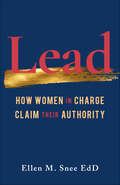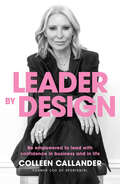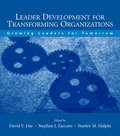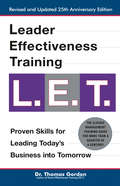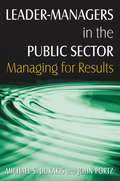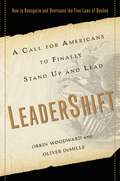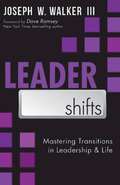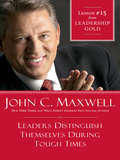- Table View
- List View
Lead: How Women in Charge Claim Their Authority
by Ellen M. SneeDuring Ellen Snee’s eighteen years as a Catholic nun, she gained a number of essential—and, happily, transferable—skills: how to discern a call or deep desire, how to work collaboratively with other women, and how to be a savvy operator within male hierarchies. In Lead, she draws on that knowledge—as well as lessons learned and insights gained from her Harvard dissertation on psychological dimensions of authority for women, two decades of work with executive women as CEO of Fine Line Consulting, and five years as VP of Organizational & Leadership Development at VMware, a global technology leader—to address the exercise of authority by women. Lead guides readers through specific challenges of leadership Snee has identified as most vital to success through her own corporate experience and consulting work: developing resilience, presenting with authority, gaining financial literacy, managing in every direction, and more. Throughout, Snee urges women to find and speak with their unique voice and claim their personal power. Full of illuminating personal and client anecdotes and surprising research insights, Lead is an accessible, instructive, and empowering road map to finding external success—by drawing on the strengths you’ve carried inside you all along.
Leader By Design: Be empowered to lead with confidence in business and in life
by Colleen CallanderThe inspirational true story of former Sportsgirl CEO Colleen Callander's rise to the top and her lessons for those looking to step up.Before we can lead anyone else, we need to be leading in our own lives.In Leader by Design, Colleen Callander aims to inspire all women to have a voice, live with purpose, lead in their own lives, change the rules, live with confidence and embrace their superpowers.She also aims to inspire organisations to embrace a new era of leadership - one that leads with kindness, trust and authenticity and one that has more women at the helm.A wife, mother of three, and chronic high-achiever, Colleen left school at the age of 16 and became state manager of a national retail brand within a few short years. She went on to become a top female CEO - but not before she almost threw in the towel, burdened under the crushing weight of burnout.Colleen held the role of CEO for 13 years, over which time her mission was to empower, engage, inspire and allow people to bring their best selves to work each day. This book is part autobiography, sharing Colleen's life journey (including how her upbringing shaped the women and leader she is today), and it is part guide/pocket mentor, full of actionable tips, advice, actions and insights to help women step into their confidence and lead with purpose.Each chapter shares insights and tips, is thought-provoking, and will empower and inspire all women who, no matter at what stage they are in on their leadership journey in business or in life, to believe that the best is yet to come. Leader By Design will ignite the courage and confidence to believe in your own superpower and believe in and embrace the positive influence that women can have on the world today through the way we lead. Perfect for job seekers, new graduates, and experienced professionals, this practical, invaluable guide will have you prepared, ready and positioned for career success.
Leader Development for Transforming Organizations: Growing Leaders for Tomorrow (Applied Psychology Series)
by David V. Day Stephen J. Zaccaro Stanley M. HalpinThis book examines numerous topic areas that are considered to be especially relevant for making a strategic leader development investment. The topics covered are areas that have theoretical and empirical connections to important aspects of growth, change, adult development, and underlying abilities, skills, and competencies needed to lead effectively in times of great complexity. In addition, these are investment areas identified by the U.S. Army--a world-class organization faced with the need for radical transformation--as particularly relevant for success and survival. This book identifies key concerns in developing leaders and leadership, and in transforming organizations to better meet the challenges of a complex world.There are two aspects of this book that distinguish it from the numerous existing volumes on leadership in the scholarly and popular-press literatures. Most important, the overarching focus of the present book is on development. There are many offerings on the topic of leadership, but relatively few that focus on leader development--especially from a scholarly, academic perspective. Also, this volume offers a unique perspective in examining those underlying psychological competencies and processes that are viewed as especially relevant for leader development.The chapters that are collected in this edited volume were originally commissioned by the U.S. Army Research Institute as "white papers" to better help Army officers and researchers understand important issues in leader development. The present organization of the papers is around four central themes: a) Accelerating Leader Development, b) Cognitive Skills Development, c) Developing Practical and Emotional Intelligence, and d) Enhancing Team Skills.
Leader Development in Army Units
by Peter Schirmer Nancy E. Blacker James C. Crowley Henry A. Leonard Richard R. BrennanSummarizes discussions with over 450 Army officers (lieutenants through colonels) about leader development in Army units. These discussions revealed that the type and extent of leader development activities vary greatly across units, but that they are generally informal and most heavily influenced by the unit commander. The authors conclude with suggestions on how the Army school system can improve leader development.
Leader Effectiveness Training: Proven Skills for Leading Today's Business into Tomorrow
by Thomas GordonL.E.T. has changed countless corporations and private businesses-including many Fortune 500 companies-with its down-to-earth communication and conflict resolution skills. Now, this indispensable source has been newly revised with updated research and timely case studies.
Leader Interpersonal and Influence Skills: The Soft Skills of Leadership (ISSN)
by Ronald E. RiggioThis edited volume explores different models, conceptualizations, and measures of leader interpersonal and influence "soft skills" that are so necessary for effective leadership. These include the communication skills, persuasion skills, political savvy, and emotional abilities used by leaders to inspire, motivate, and move followers toward the accomplishment of goals. The book emanates from the two-day-long 21st Kravis-de Roulet leadership conference, which brought together top scholars working in this area. The intent of the conference and this edited volume is to increase understanding of the interpersonal and influence skills, or "soft skills," of the leader, to highlight state-of-the-art research on the topic, and to provide clear, research-based guidelines for the development of leader skills.Chapter authors are recognized experts in their respective areas, and each section of the book will be introduced by an editor-authored chapter reviewing the specific topic area in brief.
Leader Interpersonal and Influence Skills: The Soft Skills of Leadership (Leadership: Research and Practice)
by Ronald E. Riggio Sherylle J. TanThis edited volume explores different models, conceptualizations, and measures of leader interpersonal and influence "soft skills" that are so necessary for effective leadership. These include the communication skills, persuasion skills, political savvy, and emotional abilities used by leaders to inspire, motivate, and move followers toward the accomplishment of goals. The book emanates from the two-day-long 21st Kravis-de Roulet leadership conference, which brought together top scholars working in this area. The intent of the conference and this edited volume is to increase understanding of the interpersonal and influence skills, or "soft skills," of the leader, to highlight state-of-the-art research on the topic, and to provide clear, research-based guidelines for the development of leader skills.Chapter authors are recognized experts in their respective areas, and each section of the book will be introduced by an editor-authored chapter reviewing the specific topic area in brief.
Leader Work: Using Insight, Intuition and Imagination to Develop Leadership Practice
by Paul HibbertLeader Work offers an accessible and engaging introduction to the power of reflection to support leaders in their development and professional practice. The book does not present a tick-box toolkit to being a better leader, instead it provides the prompts and deeper reflexive space for leaders to consider their own self-development.Written by a leading management researcher and consultant, the book draws on reflexive practice, but goes beyond this method to guide the reader on how to consider both inward and outward work, and provides useful suggestions for application. The inward work involves developing our knowledge of ourselves, our capabilities and our limitations through self-examination and connecting with others, and so building up our capacity for judgment, and gaining confidence in using intuition and imagination thoughtfully in situations of complexity and uncertainty. The outward work involves learning to express a leader identity that is both true to ourselves and recognized by relevant groups and the organizations in which we work, so that we are trusted to help navigate and narrate a path through uncertainty.This book has been written for leaders and would-be leaders looking to develop and shape their practice, as well as scholars studying and teaching leadership classes.
Leader to Leader
by Frances HesselbeinThis volume will spark ideas, open doors, and inspire all those who face the challenge of leading in an ever-changing environment.
Leader's (Dis)Advantage
by Peter J. CoughlanProvides a rigorous description of the economic dynamics that may produce inherent advantages for large and/or first-mover firms within an industry, as well as those factors that may result in disadvantages for such leading firms. The leader advantages discussed include both size advantages, such as economies of scale and scope, network effects, and learning effect, as well as timing advantages, such as preemption, reputation effects, buyer switching costs, and patents or institutional barriers. The leader disadvantages analyzed include pioneering costs, demand uncertainty, technological uncertainty, and incumbent inertia. Throughout the note, the experiences of Intel Corp., the world's largest manufacturer of semiconductors, are used to provide specific examples of the causes and consequences of leader advantages and disadvantages.
Leader's Challenge: Resonant Leadership
by Annie Mckee Richard BoyatzisThis chapter addresses the leader's primary challenge of igniting people's passion and mobilizing the resources of the organization toward the emerging and unpredictable future, drawing from the experiences of two real leaders.
Leader(ship) Development
by Scott A. SnookDesigned for use in the first year of an MBA program, can be included within a core course on leadership or used more broadly to orient students to their upcoming experience while in school. Offers a series of robust conceptual models to help students frame their leader(ship) development experiences while in a business school. How we frame our experiences has a significant impact on how we ultimately "have" our experiences, as well as what we make of them. Drawing broadly from educational, human development, and leadership training literature, as well as a recent longitudinal study of MBA students, speaks directly to business school students in their own language in an attempt to help them make the most out of their experiences while in school. For faculty, can be used as a background resource for understanding how MBA students experience their time in school and for grasping a broad review of the leadership development literature as it applies to MBA programs. Commonly asked questions explored include: Are leaders born or made? When we talk about "leader(ship) development," exactly what is it that is developing? How do leaders develop? To address these fundamental questions, integrates colorful student quotes with primary source insights from the major thought leaders in the field of leadership development. Also offers a series of "developmental propositions" to increase the likelihood that students will get the most out of their developmental journeys.
Leader-Managers in the Public Sector: Managing for Results
by Michael S. Dukakis John H. PortzHighlights the skills and practices necessary for effective leader-managers in the public sector. It begins by clarifying the differences between leadership and management. It then draws on in-depth interviews with seven successful leader-managers in different policy fields to identify six critical skills and practices that are necessary for good leadership and good management in the public sector.
Leader-Member Exchange and Organizational Communication: Facilitating a Healthy Work Environment (New Perspectives in Organizational Communication)
by Leah M. Omilion-Hodges Jennifer K. PtacekIt is hard to overstate the importance of the leader-member exchange relationship. Employees who share a high-quality relationship with their leader are more likely to earn a higher salary, climb the ranks more quickly, and report higher life satisfaction levels than their peers who have a less copasetic leader-member relationship. While Leader-Member Exchange Theory (LMX) research addresses the impact that the leader-member relationship has on the individual employee experience, much of this scholarship overlooks or obscures the vital role that communication plays in the development and maintenance of workgroup relationships. Much of extant literature also glosses over the role that communication plays in workgroup collaboration. Using a communicative lens, this text illustrates the complex theoretical underpinnings of LMX theory, such as the importance of social interaction and relationship building and maintenance necessary to achieve organizational goals. We explore how an employee’s relationship with their leader also shapes their peer relationships and their overall standing within their workgroup. Further, the text examines the potential dark side of LMX theory, such as the tendency towards demographic and trait and state similarity. Employing a communicative perspective emphasizes the extent of position and personal power both leaders and members have in engineering the quality of the relationship they desire. Integrating and applying once disparate lines of academic literature, this book offers employees, students, and teacher-scholars pragmatic yet research-based insights into developing and maintaining successful, healthy workplace relationships.
Leader-as-Architect: Alignment
by Joshua D. Margolis Ryan Raffaelli Ethan S. BernsteinPart of a leader's job is to equip the organization to transform inputs into outputs by defining organizational strategy, shaping organizational identity, and then managing four organizational components-formal organizational structure, culture, people, and critical tasks-such that each component, and their interaction, aligns to produce performance. Substantial research has demonstrated that well-aligned organizations will be more capable of (1) attaining strategic goals, (2) efficiently utilizing resources to do so, and (3) adapting to unforeseen, future challenges. This short note walks through the Congruence Model, a simple yet powerful tool for achieving alignment in an organization.
LeaderShift: A Call for Americans to Finally Stand Up and Lead
by Orrin Woodward Oliver DemilleA most provocative business parable for our troubled times, LeaderShift is the story of how David Mersher, the successful CEO of IndyTech, sets out to discover why the United States is losing its leadership edge and what he can do to turn things around and make America truly great again.In the process, Mersher and his team learn how the Five Laws of Decline are eroding the nation's economy-quietly ruining businesses and big institutions-and what American executives and citizens need to do to put a stop to this.Above all, Mersher and his colleagues discover something few business leaders or citizens of free nations have yet to realize: Our world today is on the verge of a momentous LeaderShift, one which will reframe the twenty-first century and significantly alter the way we govern, lead, and do business.When Mersher and his team get help from a surprising source, the result is stunning and unexpected-and it's one that concerned Americans will certainly reflect upon for decades to come.The next LeaderShift is almost here.Are you ready?
LeaderShifts: Mastering Transitions in Leadership & Life
by Joseph W. Walker IIIOur world isn’t slowing down, so only those who are willing to maneuver the tectonic cultural shifts will have sustainable ministry. From his extensive experience and using the biblical story of Joseph as an extended metaphor, Bishop Joseph Walker shares practical wisdom designed to help leaders reach out and equip their church to share a relevant Christian message.Joseph W. Walker III is bishop of Mount Zion Baptist Church of Nashville, Tennessee. Under his leadership and over a span of twenty years, the church has grown from 175 to more than 28,000 members. During this time, Bishop Walker has seen people struggle to embrace the new things God is doing; and he fully appreciates how change heightens the demands of leadership.Shifting approaches to follow where God leads can also mean that leaders have to risk confronting cherished tradition, which Bishop Paul Morton calls “frozen success.” But shifting to meet new opportunities is also a delicate balance that acknowledges history while also being sensitive to those loyal people who have sustained the organization to this point. Effective leadership does not impose new ideas upon old systems without a strategy that enables everyone in the organization moving forward together. It’s not simply, “out with the old and in with the new.” Successful organizations do not forget their history, but they commit themselves to using it as a bridge to propel them to their destiny.
Leaders Affirm Strategies: How Clearly Communicating Your Strategy Speeds Execution of Large-Scale Initiatives
by Henry M. Frechette Edwin H. Boswell Jocelyn R. DavisSuccess in business is all about creating the most value faster than the competition. Yet research shows that only 30% of strategic initiatives fully succeed on time, even with streamlined processes in place, detailed metrics to chart the course, and plenty of resources on hand to get the job done. Why? Because an exclusive focus on pace and process often leads to superficial results: lots of activity, but little forward motion. In this chapter, the authors focus on the first of four leadership practices proven to increase strategic speed: strategy affirmation. Strategy affirmation is key because before you can drive speed of execution, you must ensure that your people know where they're going and are motivated to get there. Strategy affirmation consists of three leadership imperatives: 1) Understanding the components of a complete strategy; 2) being aligned and alert; and 3) helping others buy in to the strategy. Using real-world examples from Holiday Inn, Morgan Stanley, and Tata Sky, the authors explain the components of a good strategy, what it means to be aligned and alert, and how to achieve buy-in. The chapter concludes with a brief self-assessment to help you size up your personal effectiveness at affirming your organization's strategies. This chapter was originally published as Chapter 3 of "Strategic Speed: Mobilize People, Accelerate Execution."
Leaders Affirm Strategies: How Clearly Communicating Your Strategy Speeds Execution of Large-Scale Initiatives
by Henry M. Frechette Edwin H. Boswell Jocelyn R. DavisSuccess in business is all about creating the most value faster than the competition. Yet research shows that only 30% of strategic initiatives fully succeed on time, even with streamlined processes in place, detailed metrics to chart the course, and plenty of resources on hand to get the job done. Why? Because an exclusive focus on pace and process often leads to superficial results: lots of activity, but little forward motion. In this chapter, the authors focus on the first of four leadership practices proven to increase strategic speed: strategy affirmation. Strategy affirmation is key because before you can drive speed of execution, you must ensure that your people know where they're going and are motivated to get there. Strategy affirmation consists of three leadership imperatives: 1) Understanding the components of a complete strategy; 2) being aligned and alert; and 3) helping others buy in to the strategy. Using real-world examples from Holiday Inn, Morgan Stanley, and Tata Sky, the authors explain the components of a good strategy, what it means to be aligned and alert, and how to achieve buy-in. The chapter concludes with a brief self-assessment to help you size up your personal effectiveness at affirming your organization's strategies. This chapter was originally published as Chapter 3 of "Strategic Speed: Mobilize People, Accelerate Execution."
Leaders Building Leaders: Tools for Developing Results-Based Leaders
by Dave Ulrich Norm Smallwood Jack ZengerUltimately, the results-based leader succeeds because the next generation of leaders exceeds the results of the current generation. This chapter provides leaders with a road map for building a deep leadership bench and suggests innovative ways to invest development dollars most effectively to upgrade the quality of leadership.
Leaders Can Make a Difference: It's in Their Hands
by Harvard Business Review PressFor an idea generated by a middle manager to reach its full potential, there must be some support from higher ranking individuals. These people play an important role in shaping the culture, giving direction, and allocating funds. This chapter explains the importance of involving senior management and outlines what leaders must do to assure that innovation flourishes. This chapter is excerpted from "Harvard Business Essentials: Innovator's Toolkit" and was adapted from "Harvard Business Essentials: Managing Creativity and Innovation."
Leaders Cultivate Experience: Creating Strategic Speed by Harnessing the Experience of Your Workforce
by Henry M. Frechette Edwin H. Boswell Jocelyn R. DavisJust as a leader's ability to create a workplace climate in which employees feel competent, engaged, and appreciated can accelerate strategic results, so too can a leader's ability to "cultivate experience"-to bring individuals' and teams' experience into view, make it significant, share it, and harness it-increase strategic speed. In this chapter, the authors describe four competencies leaders need in order to capture the experience and wisdom latent in their organizations and put it to work: conscious practice, openness, reflection in action, and experimentation. Using examples such as mobile communications giant Vodafone Group, health insurer Regence, and Irving Oil, they show how an organization's collective wisdom and experience can become a powerful driver of results. The chapter concludes with a brief self-assessment to help you size up your personal effectiveness at cultivating the experience of your workforce. This chapter was originally published as Chapter 6 of "Strategic Speed: Mobilize People, Accelerate Execution."
Leaders Distinguish Themselves During Tough Times
by John MaxwellSmart leaders learn from their own mistakes. Smarter ones learn from others' mistakes--and successes. John C. Maxwell wants to help you become the smartest leader you can be by sharing Chapter 15, Leaders Distinguish Themselves During Tough Times, of Leadership Gold with you. After nearly forty years of leading, Maxwell has mined the gold so you don't have to. Each chapter contains detailed application exercises and a "Mentoring Moment" for leaders who desire to mentor others using the book.
Leaders Drive Initiatives: How to Accelerate Strategic Execution Through Active Support and Coaching
by Henry M. Frechette Edwin H. Boswell Jocelyn R. DavisSuccess in business is all about creating the most value faster than the competition. Yet research shows that only 30% of strategic initiatives fully succeed on time, even with streamlined processes in place, detailed metrics to chart the course, and plenty of resources on hand to get the job done. How can you improve the odds? The authors-all executives at The Forum, a global consulting firm-argue that three often overlooked "people factors" are key drivers of strategic speed: clarity, unity, and agility. Their research reveals that leaders who are successful in driving strategic speed increase these people factors by consistently applying four practices. In this chapter, they take a closer look at the second practice: driving initiatives. Leaders, they argue, need to do more than "sponsor" initiatives; they need to follow an execution model that comprises seven success factors-all of which are more about people than they are about processes and technology. The chapter concludes with a brief self-assessment to help you size up your personal effectiveness at driving initiatives. This chapter was originally published as Chapter 4 of "Strategic Speed: Mobilize People, Accelerate Execution."
